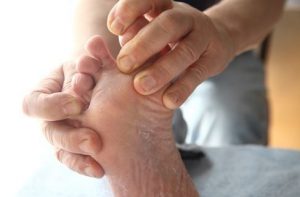Managing Toes: Hammertoe Surgery to Conservative Methods
 Perpetually bent toes, like hammertoes, are a problem for your feet. They’re uncomfortable and can make it difficult for you to walk normally, especially when you wear shoes. Caused by muscle imbalances, they only get worse the longer they go unaddressed. Hammertoe treatment without surgery, as well as hammertoe surgery itself, are options for restoring your foot to health.
Perpetually bent toes, like hammertoes, are a problem for your feet. They’re uncomfortable and can make it difficult for you to walk normally, especially when you wear shoes. Caused by muscle imbalances, they only get worse the longer they go unaddressed. Hammertoe treatment without surgery, as well as hammertoe surgery itself, are options for restoring your foot to health.
Noninvasive Methods
Most digital deformities can be treated quite successfully using conservative methods, especially if the toe has remained flexible. Hammertoe treatment without surgery can range from shoe changes to physical therapy. Our doctors will evaluate your lower limbs to determine how severe your condition is and if any underlying problems may be contributing to the issue. Then, our staff will work with you to find the most effective therapies to relieve your discomfort.
You’ll most likely need to adjust your footwear to make sure you have plenty of room for your digits to move and spread out as they need. Shoes with narrow, shortened, or pointed toe boxes cramp the end of the foot and may encourage the tendons supporting the toes to become imbalanced. High heels force the digits forward in the shoe, too, adding pressure to them. Instead, switch to shoes with wide, deep toe boxes and sufficient arch support. Orthotics that help cushion and stabilize the foot may help as well. They can also manage any underlying conditions that may have either caused or worsened your problem.
Padding and icing your toes may relieve some of your discomfort. The pads will protect your bent digits from rubbing uncomfortably against your shoes. Ice will help decrease any inflammation that has developed in the toe. Since the problem is the result of imbalanced tendons, though, physical therapy exercises may help your foot work through the problem. Stretching the tightened tissues helps them to relax and not pull so painfully on the digits. Strengthening the foot overall helps you build up your weakened foot muscles so you toe stays more balanced. If your pain is persistent, you may still need anti-inflammatory medications.
Surgery for Success
Sometimes, however, hammertoe surgery is your best option for recovery. If your foot is not responding to noninvasive therapies, you may need a procedure to repair the damage. Modern surgeries have come a long way with advances in medical technology, making them safer than ever. The procedure can also be done in multiple ways. Which technique is used will depend on your lifestyle, your health, and on how rigid and deformed your toe has become. Our team will discuss all your options with you and help you decide which procedure will most benefit your foot.
Sometimes parts of the toe bones need to be cut away. This helps with any damaged bone or arthritis that may be keeping the toe rigid. Sometimes the tendons are released, or even moved, so they aren’t bending the toe inward. The tissue is clipped and either attached in a new place to help balance the toe, or only partially cut so that the tissue lengthens and doesn’t pull so strongly on the digit. If the damage to the toe is more severe, the affected joint may need to be fused. That way, the bent digit will be permanently restored to its correct position.
Whether you have a procedure to fix your digit or you decide to stick to hammertoe treatment without surgery, managing your condition promptly is the key to restoring your foot. The longer you wait to deal with your discomfort, the more difficult it will become to restore your lower limbs to full health.
Don’t let fear of hammertoe surgery keep you from seeking the remedy you need. Contact our expert team here at Dallas Podiatry Works for more information or make an appointment to take care of your feet. You can send us a request through our online contact page or call either of our two offices to reach us: 972.853.7100 for our Dallas location; (972) 943-3323 for our Plano office.

 Perpetually bent toes, like hammertoes, are a problem for your feet. They’re uncomfortable and can make it difficult for you to walk normally, especially when you wear shoes. Caused by muscle imbalances, they only get worse the longer they go unaddressed. Hammertoe treatment without surgery, as well as hammertoe surgery itself, are options for restoring your foot to health.
Perpetually bent toes, like hammertoes, are a problem for your feet. They’re uncomfortable and can make it difficult for you to walk normally, especially when you wear shoes. Caused by muscle imbalances, they only get worse the longer they go unaddressed. Hammertoe treatment without surgery, as well as hammertoe surgery itself, are options for restoring your foot to health.


